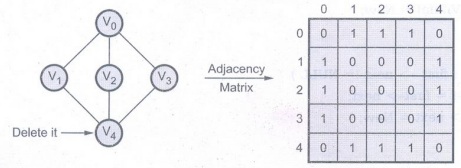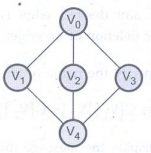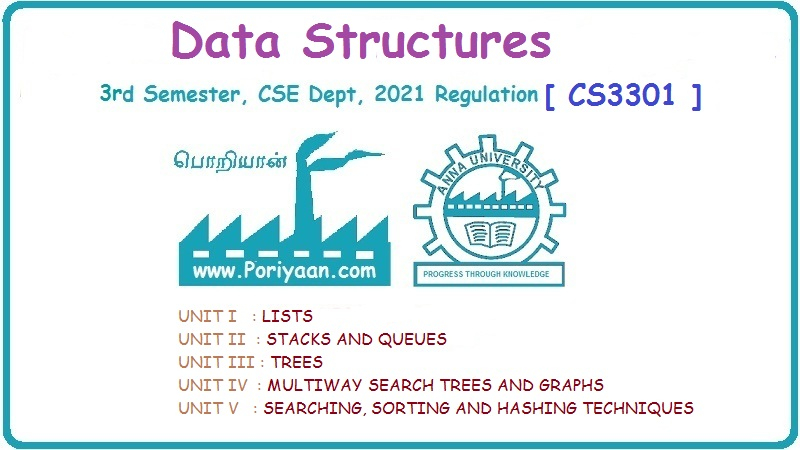Data Structure: Unit IV : Multiway Search Trees and Graphs
Graph Operations
with Example C Programs | Data Structure
Creation of graph using adjacency matrix is quite simple task. The adjacency matrix is nothing but a two dimensional array.
Graph Operations
1. Graph creation using adjacency matrix
Creation
of graph using adjacency matrix is quite simple task. The adjacency matrix is
nothing but a two dimensional array. The algorithm for creation of graph using
adjacency matrix will be as follows:
1. Declare
an array of M[size] [size] which will store the graph.
2. Enter
how many nodes you want in a graph.
3. Enter
the edges of the graph by two vertices each, say V1, V; indicates some edge.
4. If
the graph is directed set M[i][j]M[j][i]=1 as well.1. If graph is undirected
set M[i][j]= 1 and
5. When
all the edges for the desired graph is entered print the graph M[i][j].
void
create()
{
int v1,
v2
char
ans='y';
printf("\n\t\t
This is a Program To Create a Graph");
printf("\n\t\t
The Display Is In Breadth First Manner");
printf("\nEnter
no. of nodes");
scanf("%d",&n);
for (v1
= 0; v1 < n; v1++)
for (v2
= 0; v2 < n; v2++)
g[v1][v2]
= FALSE;
printf("\nEnter
the vertices no. starting from 0");
do
{
printf("\nEnter
the vertices v1 & v2");
scanf("%d
%d", &v1, &v2);
if (v1
>= n || v2 >= n)
printf("Invalid
Vertex Value\n");
else
{
g[v1][v2]=TRUE;
g[v2][v1]
= TRUE;
}
printf("\n\nAdd
more edges??(y/n)");
ans=getche();
}
while(ans=='y');
}
2. Graph creation using adjacency list
1.
Declare node structure for creating adjacency list.
2.Initialize
an array of nodes. This array will act as head nodes. Say "*head [10]'.
The index of head [ ] will be the starting vertex.
3. The
create function will create the adjacency list for given graph G as follows -

void
create()
{
int V1,
V2;
char
ans='y';
for (V1=
0; V1 < MAX; V1++)
head[V1]
= NULL;
do
{
printf("\nEnter
the Edge of a graph \n");
scanf("%d
%d", &V1,&V2);
if
(V1>= MAX || V2 >= MAX)
printf("\nInvalid
Vertex Value\n");
else
InsertEdge(V1,
V2);
printf("\n\nAdd
More nodes??");
ans=getche();
}while(ans=='y');
}
void
add(int Hnode, int Vnum)
{
node
*New, *first;
New =
(node *)malloc(sizeof(node ) );
if (New
== NULL)
printf("\n
Memory can not be allocated\n");
New->
vertex = Vnum;
New->next
= NULL;
first
=head[Hnode];
if
(first == NULL)
head[Hnode]=New;
else
{
while
(first -> next != NULL)
first=first->next;
first->next
= New;
}
New= (node
*)malloc(sizeof(node ) );
if (New ==NULL)
printf("\n
Memory Can not be allocated\n");
New->
vertex = Hnode;
New->next
= NULL;
first =
head[Vnum];
if
(first == NULL)
head[Vnum]
New;
else
{
while
(first -> next != NULL)
first = first->next;
first->next
= New;
}
}
3. Vertex Insertion
The
vertex can be inserted in a graph by adding name of new vertex and name of the
existing vertex to which it is attached.
For example:
Consider
a graph G given below

4. Vertex Deletion
When
particular vertex is deleted then all the edges associated with it gets
deleted. All these edges are actually attached to neighbouring vertices. Hence
while deleting some particular vertex, ask for the names of neighbouring
vertices.

The
neighbouring vertices are V1, V2, V3.
Set
G[V4][V1]
= G[V1][V4]= 0
G[V4][V2]
= G[V2][V4] = 0
G[V4][V3]
= G[V3][V4] = 0

Thus
vertex V4 gets deleted.
5. Find Vertex
For
finding out the desired vertex we need to scan the complete graph. If vertex is
present, then we will display its adjacent or neighbouring vertices.
For example
If we search for vertex V4 then the vertices V1, V2 and V3 are neighbouring vertices.

If the
given vertex is not present in the graph then there will not be the
neighbouring vertices. Hence we can simply display a message - "vertex not
found".
6. Edge Addition
We can
insert an edge in the graph. The edge is always represented by two vertices.
Following are the steps to be carried out for adding an edge in the existing
graph.
Step 1: Enter the name of new edge
by specifying two vertices, say V1, V2
Step 2: Set G[V1][V2]= G [V2 ][V1]= 1

7. Edge Deletion
Deletion
of any desired edge is the simplest operation. Following are the steps to be
followed for deletion of an edge.
Step 1: Specify the name of an edge
by two vertices say V1 and V2.
Step 2: Set G[V1] [V2]=
G[V2] [V1]=0.
Step 3: Display the message that the
edge is deleted.
For example:
If we
want to delete an edge V2 - V3 then

Data Structure: Unit IV : Multiway Search Trees and Graphs : Tag: : with Example C Programs | Data Structure - Graph Operations
Related Topics
Related Subjects
Data Structure
CS3301 3rd Semester CSE Dept | 2021 Regulation | 3rd Semester CSE Dept 2021 Regulation
